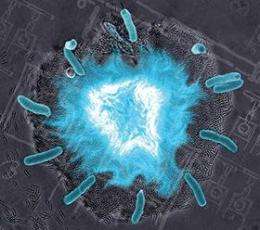Researchers synchronize blinking 'genetic clocks' (w/ Video)

Researchers at UC San Diego who last year genetically engineered bacteria to keep track of time by turning on and off fluorescent proteins within their cells have taken another step toward the construction of a programmable genetic sensor. The scientists recently synchronized these bacterial "genetic clocks" to blink in unison and engineered the bacterial genes to alter their blinking rates when environmental conditions change.
Their latest achievement, detailed in a paper published in the January 21 issue of the journal Nature, is a crucial step in creating genetic sensors that might one day provide humans with advance information about temperature, poisons and other potential hazards in the environment by monitoring changes in the bacterium's blinking rates.
"Programming living cells is one defining goal of the new field of synthetic biology," said Jeff Hasty, associate professor of biology and bioengineering at UCSD who headed the research team with Lev Tsimring, associate director of UCSD's BioCircuits Institute.
"Dr. Hasty and colleagues have used powerful genetic tools, backed by decades of detailed knowledge of bacterial processes, to create a system that delivers on the promise of synthetic biology - to engineer living organisms to meet pressing societal needs," said James Anderson, who oversees computational biology grants at the NIH's National Institute of General Medical Sciences. "The oscillating system they engineered sets the stage for the development of highly sensitive sensors that could have multiple applications in basic research, biotechnology and medicine."
"Synchronization of clocks and oscillators in general has been a fascinating subject for physicists and applied mathematicians for centuries," said Tsimring. "This began with the Dutch mathematician and astronomer Christiaan Huygens, who is credited with its serendipitous discovery in 1665 when he suspended a pair of nearly identical pendulum clocks (which he invented and patented some 8 years earlier) on the same wooden beam."
"Synchronization plays a crucial role in physics and biology as a way of self-organization of highly regular behavior with less that perfect components. This phenomenon has a myriad of applications in modern technology, from communication networks to GPS. Our study demonstrates how inherently noisy gene oscillators can operate together with beautiful synchronicity and regularity once coupled together in a specific way."
Over the past decade, researchers have gone from wiring genetic toggle switches and oscillators in living cells to building living circuits capable of pattern generation, noise shaping, edge detection and event counting. In their latest development, the UCSD researchers took advantage of a type of bacterial communication in which bacteria exchange small molecules.
"Many bacteria species are known to communicate by a mechanism known as quorum sensing, that is, relaying between them small molecules to trigger various behaviors," said Hasty. "Other bacteria are known to disrupt this communication mechanism by degrading these relay molecules."
Taking these communication elements from different organisms, Hasty and his team of researchers—who included UCSD bioengineering graduate students Tal Danino and Octavio Mondragon—designed and constructed a network in the genetic model bacterium E. coli with positive and negative feedback components to produce a colony of synchronized clocks.
Hasty said the architecture of the circuit is similar to his team's previous genetic clock (see: www.physorg.com/news144506053.html), but with the quorum sensing components allowing the phase information—that is, the oscillations between the bacterial cells—to be relayed.
The researchers constructed devices to precisely control the sizes of the bacterial colonies between two different scales: a micron, or a millionth of a meter, and a millimeter, or one-thousandth of a meter. At the micron scales, Hasty said the cells in the colonies oscillate synchronously from 50 to 90 minutes, a period that can be tuned externally. But at the longer, or millimeter scales, he noted, the time for diffusion of the signal becomes more important, allowing the researchers to actually observe the propagation of the signal through the colony.
"The use of quorum sensing is a promising approach to increase the sensitivity and robustness of the dynamic response to external signals," said Hasty. "In nature, synchronization typically helps stabilize a desired behavior arising from a network of intrinsically noisy and unreliable elements. We think the synchronized genetic clock sets the stage for the use of microbes as a macroscopic biosensor with oscillatory output, or applications of using a synchronized periodic signal in drug delivery."
Provided by University of California - San Diego
















